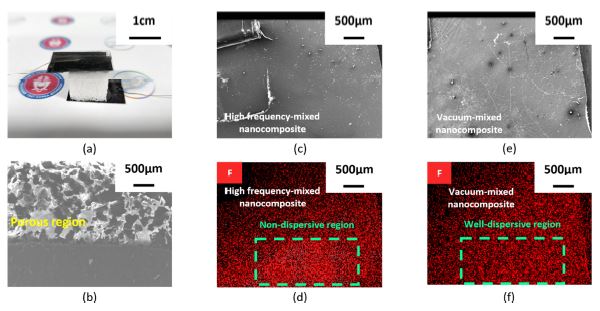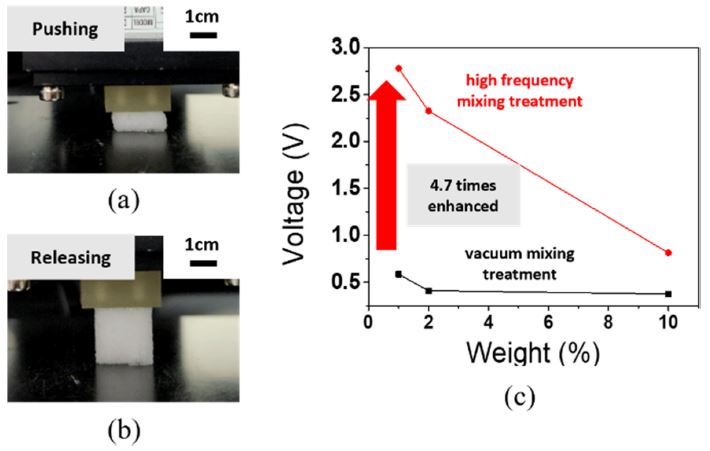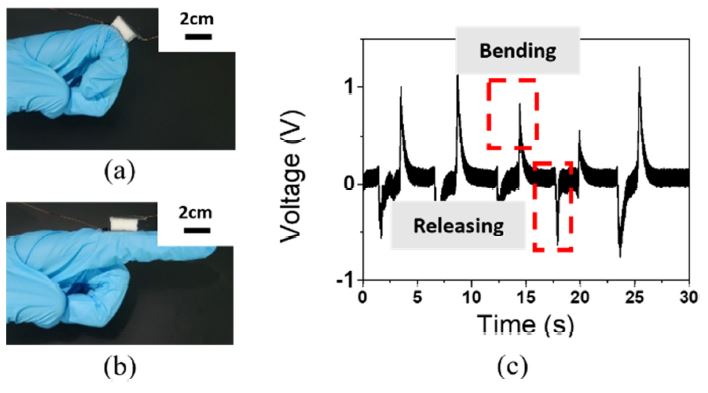
PVDF 나노 복합체 기반 3차원 다공성 압전 응력 센서
This is an Open Access article distributed under the terms of the Creative Commons Attribution Non-Commercial License(https://creativecommons.org/licenses/by-nc/3.0/) which permits unrestricted non-commercial use, distribution, and reproduction in any medium, provided the original work is properly cited.
Abstract
With the development of Internet of Things (IoT) technologies, numerous people worldwide connect with various electronic devices via Human-Machine Interfaces (HMIs). Considering that HMIs are a new concept of dynamic interactions, wearable electronics have been highlighted owing to their lightweight, flexibility, stretchability, and attachability. In particular, wearable strain sensors have been applied to a multitude of practical applications (e.g., fitness and healthcare) by conformally attaching such devices to the human skin. However, the stretchable elastomer in a wearable sensor has an intrinsic stretching limitation; therefore, structural advances of wearable sensors are required to develop practical applications of wearable sensors. In this study, we demonstrated a 3-dimensional (3D), porous, and piezoelectric strain sensor for sensing body movements. More specifically, the device was fabricated by mixing polydimethylsiloxane (PDMS) and polyvinylidene fluoride nanoparticles (PVDF NPs) as the matrix and piezoelectric materials of the strain sensor. The porous structure of the strain sensor was formed by a sugar cube-based 3D template. Additionally, mixing methods of PVDF piezoelectric NPs were optimized to enhance the device sensitivity. Finally, it is verified that the developed strain sensor could be directly attached onto the finger joint to sense its movements.
Keywords:
Wearable sensor, 3D-porous structure, PVDF nanoparticles, Piezoelectric sensor, Nanocomposite1. 서 론
4차 산업혁명이 도래함에 따라 사물 인터넷 (Internet of Tings)은 헬스케어, 자동차, 제조 등 다양한 분야에 활용되고 있다 [1-3]. IoT의 핵심 기술 중 하나인 인간-기계 인터페이스 (human-machine interface, HMI)는 인간과 기계간의 밀접한 상호관계를 가지게 했으며 사물 인터넷의 발전에 큰 영향을 미친 기술이다. HMI가 많은 관심을 가짐에 따라 사용자와 기계는 더욱 긴밀한 관계를 가지게 되었으며 현재는 인터페이스에서 더 발전된 방향인 상호작용 (Interaction)으로 활용되고 있다 [4].
이렇게 HMI가 상호작용의 개념으로 자리잡음으로써 웨어러블 기술이 주목받고 있다. 신체의 변형에 즉각적으로 반응해야 하는 웨어러블 디바이스는 강체가 아닌 탄성체를 주로 사용하고 있다. 이는 신체의 대부분이 유연하고 굴곡진 움직임을 가져 디바이스를 이루는 재료가 적절한 변형성과 회복성을 요구하기 때문이다 [5]. 탄성체를 사용하는 웨어러블 디바이스 연구는 여기에 그치지 않고 탄성체 속에 나노 크기의 로드, 와이어, 입자 등과 혼합하여 나노 복합체 기반 응력 센서로 응용하는 연구들이 매우 활발히 진행되고 있다 [6-8]. 하지만 지금까지는 응력 센서가 신체의 급격한 변형과 순간적인 힘을 버티지 못하고 디바이스가 파괴될 수 있다는 한계점을 지니고 있었다. 따라서, 소자를 구성하는 탄성체의 구조를 새롭게 디자인해 소자의 인장능력을 극대화할 필요가 있으며, 이는 웨어러블 응력 센서의 구현을 위해 꼭 해결되어야 할 과제이다 [9].
복합체가 함유하고 있는 나노 입자의 분산도는 복합체의 기계적/전기적 특성과 직접적으로 연관되어 있으며, 이를 발전시키고자 다양한 연구결과가 보고된 바 있다 [10-12]. 분산도를 향상시키기 위해 분산제, 밀링 (milling), 고압 균질기 (homogenizer) 등 다양한 방법들이 적용되어 왔는데, 이들은 여전히 화학적 용제 사용에 따른 안전성, 사용자의 숙련도에 따른 오차, 고가의 장비라는 한계를 지니고 있다.
본 연구에서는 나노 복합체 기반 3차원 다공성 압전 응력 센서를 구현하였다. 나노 복합체는 무독성의 Polyvinylidene fluoride (PVDF) 나노 입자를 Polydimethylsiloxane (PDMS)에 분산시켜 만들었으며, 각설탕 템플릿을 이용함으로써 내부에 기공이 함유된 3차원 구조체를 만들 수 있었다 [13]. 개발된 3차원 다공성 나노 복합체는 최적화된 분산 방법에 의해 제작되었으며, PVDF 나노 입자의 분산도는 재료분석을 통하여 확인할 수 있었다. 최종적으로 개발된 3차원 다공성 나노 복합체는 웨어러블 응력센서로 응용되었으며, 내부에 압전 PVDF 입자를 함유하고 있어, 압력이나 굽힘과 같은 기계적 힘에 따라 전기적 신호를 보였다.
2. 연구 방법
2.1 3차원 다공성 압전 복합체 제작
Fig. 1은 PDMS 혼합체에 PVDF를 분산하여 3차원 다공성 압전 복합체를 제작하는 전체 과정을 보여준다 (Fig. 1(a)). 먼저, PDMS 베이스 물질에 경화제를 10:1의 질량비로 혼합한 뒤, PVDF 나노 입자를 1, 2, 10%의 질량 백분율로 분산시켰다. 분산된 혼합체는 진공 데시케이터 (desiccator)를 이용해 10분간 진공처리를 해줌으로써, 내부의 기포를 제거하였다. 다음으로는 초음파 처리기를 이용하여 10분간 고주파 혼합처리를 해주어 PDMS 혼합체 내 PVDF 나노 입자가 균일하게 분산되도록 유도하였다 (Fig. 1(b)) [14]. 3차원 다공성 구조를 형성하기 위해 각설탕을 템플릿으로 사용하였으며 (Fig. 1(c)), 제작된 나노 복합체 내에 각설탕 템플릿을 넣고 진공 처리를 하여 설탕 입자 사이로 복합체가 균일하게 침투되도록 하였다. 나노 혼합체를 70°C로 열처리하여 완전 경화 후, 각설탕 템플릿을 50°C의 탈이온수 (Deionized water)로 3시간동안 용해하여, 3차원 다공성 구조의 복합체를 형성했다 (Fig. 1(d)).
2.2 유연 압전 응력 센서 제작
압전 고분자 복합체를 웨어러블 센서로 구현하고자 Indium Tin Oxide (ITO)가 코팅된 Polyethylene Terephthalate (PET) 필름 (15 × 20 mm2)을 유연 전극으로 사용하였다. ITO-PET 필름을 3차원 다공성 압전 구조체의 상부와 하부에 부착한 뒤, 전도성 탄소 테이프를 이용하여 구리선을 연결하였다. 추가적으로 압전 고분자 복합체와 구리선 전극의 접착력을 향상시키며, 이외의 영역을 절연하고자 에폭시를 이용하여 패시베이션 (Passivation)하였다. Fig. 2(a)는 최종 구현된 3차원 다공성 압전 응력 센서를 보여준다.

(a) Optical image of the 3D-porous structured piezoelectric strain sensor. (b) Cross-sectional SEM image of porous nanocomposite, (c) and (d) SEM and EDS mapping images of vacuum-mixed PDMS-PVDF nanocomposite film. (e) and (f) SEM and EDS mapping images of high frequency-mixed PDMS-PVDF nanocomposite film.
3. 결과 및 고찰
3.1 3차원 다공성 구조 및 나노 입자 분산도 확인
개발된 복합체 기반 압전 센서가 갖고 있는 3차원 다공성 구조를 분석하기 위해 단면 Scanning Electron Microscopy (SEM) 분석을 진행하였다 (Fig. 2(b)). SEM 사진을 확인한 결과, 3차원 구조체 내부에 기공의 크기는 서로 상이하지만 구조체가 끊김 없이 연결되어 있음을 확인할 수 있었다.
나노 입자 기반 복합체를 응용한 전자 소자의 성능은 나노 입자의 분산도와 직접적인 관계가 있다 [15]. 따라서 우리는 복합체 제조 과정에 다양한 처리 방법을 적용함으로써 나노 입자의 분산도 향상을 최적화하였다. Fig. 2(c)와 (e)는 각각 진공처리, 고주파 혼합 처리를 이용해 제작한 PDMS-PVDF 나노 복합체 필름의 표면 SEM 사진이다. 이 때 복합체 내의 분산 정도를 정확히 분석하기 위해 다공성 구조가 아닌 필름 형태로 비교를 진행하게 되었다.
Fig. 2(d)와 (f)는 각각 진공 처리, 고주파 혼합처리를 이용해 제작한 PDMS-PVDF 나노 복합체 필름의 분산도를 보여주는 Energy Dispersive X-ray Spectroscopy (EDS)의 불소 (F) 원소 매핑 이미지다 Fig. 2d와 f의 녹색 점선 상자를 확인해보면, 고주파 혼합처리를 통해 PVDF 나노 입자를 분산시킨 경우, 나노 복합체 전체에 걸쳐 매우 균일하게 나노 입자가 분산됨을 확인할 수 있었다.
이를 통해 우리는 PDMS 매트릭스 내부에 서로 응집되어 있는 PVDF 나노 입자가 물리적인 힘을 지속적으로 받아 분해되고, 균일하게 분산된다는 것을 알 수 있었다 [16].
3.2 유연 압전 응력 센서의 성능 측정
3차원 나노 복합체 내 PVDF 나노 입자의 혼합양과 유연 압전 응력 센서의 성능간 관계를 확인하고자 소자에 일정한 힘을 반복적으로 가하여 출력 전압을 비교 분석해 보았다. 실험은 linear motor pushing stage에 응력 센서를 올리고 100N의 힘을 10회 반복 인가하여 진행되었으며, electrometer (Keithley 6514)를 이용해 출력 전압을 측정하였다 (Fig. 3(a), (b)). Fig. 3(c)는 PVDF 나노 입자의 혼합 방법과 양에 따른 최대 출력 전압 결과를 보여준다. 고주파 혼합처리를 통해 제작한 압전 센서는 최대 2.81V의 출력 전압을 보였고, 이는 진공 처리만 실시하여 제작한 한 센서(0.59V)보다 약 4.7배 더 높은 결과임을 확인할 수 있었다. 또한 PVDF의 혼합양에 따른 출력 전압의 경향성을 확인한 결과, 혼합된 PVDF의 질량 백분율이 증가할수록 출력 전압이 감소했으며, 이는 두 혼합 방법 모두에서 동일한 결과를 보였다. 이러한 결과는 나노 복합체 내에 많은 양의 입자가 분산될수록 복합체 매트릭스가 본질적으로 갖고 있던 인장성이 변화하게 되고, 동일한 힘을 받았을 때 더 적은 변형이 일어나기 때문이다 [17]. 따라서 3차원 구조체 전체에 응력이 가해지지 않아 내부 PVDF 압전 나노 입자가 힘을 제대로 받지 못하여 발생하는 현상으로 볼 수 있다.

(a) and (b) Photographs of the device at pushing and releasing motions. (c) Output voltage of high frequency-mixed and vacuum-mixed treated devices.
Fig. 4는 개발한 복합체가 웨어러블 응력 센서로써 인체의 기계적 변형에 적합한 거동을 보이고, 이 때 발생하는 응력 측정에 적합한지 확인하기 위해 검지 손가락 관절부위에 개발한 소자를 부착하고 분석한 결과다. 부착한 소자는 고주파 혼합처리를 적용한 압력 센서로써 PVDF 나노 입자의 질량 백분율 1%가 혼합된 소자였다. 부착된 소자의 전기적 특성은 손가락을 굽힌 상태에서 측정을 진행했고 5회의 굽힘과 회복을 각각 3초간 유지했다(Fig. 3(a), (b)). Fig. 3(c)는 검지위에 부착된 압력 센서에 대한 출력 전압 그래프를 보여준다. 결과적으로 유연 압전 응력 센서는 굽힘 상태에서 최대 1.24 V의 출력 전압을 보였으며, 수차례 반복된 움직임에도 지속적인 전기 신호를 보였다. 본 결과를 바탕으로 우리가 개발한 PVDF 나노 복합체 기반 3차원 압전 응력 센서가 웨어러블 센서로서 관절의 기계적 변형을 감지할 수 있다는 것을 확인할 수 있었다.
4. 결 론
본 연구에서는 무독성 고분자를 활용한 3차원 다공성 구조 기반 변형 센서를 제작하고 웨어러블 센서로서 가능성을 확인했다. 압전 나노 입자와 고분자 매트릭스는 각각 PVDF와 PDMS를 사용했으며 3차원 다공성 구조를 형성하기 위해 각설탕 템플릿을 활용했다. 또한, PVDF 나노 입자의 균일한 분산을 위해 고주파 및 진공 혼합처리를 각각 적용했고, SEM 및 EDS 이미지 분석을 통해 그 분산도를 비교할 수 있었다. 이러한 결과를 근거로 나노 입자의 혼합 방법에 따른 응력 센서의 출력 전압과 나노 입자의 분산양에 따른 소자의 출력 경향성을 비교분석 할 수 있었다. 출력 전압은 고주파 혼합처리를 적용한 소자가 진공 혼합처리를 적용한 소자에 비해 최대 4.7배 더 높게 측정되었으며, 분산된 PVDF양이 증가할수록 낮은 전기적 신호가 나옴을 확인했다. 마지막으로 개발된 나노 복합체 기반 3차원 다공성 압전 응력 센서의 웨어러블 소자로써 가능성을 확인하기 위해 실제 손가락에 부착하고 움직임에 따른 출력 전압을 확인했다. 굽힘 시 최대 1.24V의 전압이 측정되었다.
결과적으로 간단한 혼합 및 분산 공정을 통해 신체의 변화를 효율적으로 감지할 수 있는 3차원 다공성 응력센서를 구현할 수 있었으며, 신체에 직접 부착함으로써 기계적 변화를 감지하고 나아가 사물 인터넷, 메타버스 등 다양한 분야에 적용할 수 있는 미래 지향적 연구로 활용이 기대된다.
Acknowledgments
본 연구는 2022년 과학기술정보통신부 재원으로 한국연구재단의 지원(중견연구자지원사업 2022R1A2C4002037, 기초연구실사업 2022R1A4A3032923 및 2022R1A4A3033320)을 받아 수행된 연구입니다.
References
-
H. Yeon, H. Lee, Y. Kim, D. Lee, Y. Lee, J. Lee, J. Shin, C. Choi, J. Kang, J. Suh, H. Kim, H. Kum, J. Lee, D. Kim, K. Ko, B. Ma, P. Lin, S. Han, S. Kim, S. Bae, T. Kim, M. Park, Y. Joo, E. Kim, J. Han, and J. Kim, “Long-term reliable physical health monitoring by sweat pore-inspired perforated electronic skins”, Sci. Adv., Vol. 7, No. 27, p. eabg8459, 2021.
[https://doi.org/10.1126/sciadv.abg8459]

- M. Helmy N. Imanina, R. Ambar, A. Baharum, S. Shant, M. Suffian, S. Sanim, and H. Fahri, “IoT-Based Battery Monitoring System for Electric Vehicle Development of the Photovoltaic (PV) Module Using Artificial Neural Network (ANN) View project A Conceptual Framework for Children’s Mobile Application Using Emotional Design View project IoT-Based Battery Monitoring System for Electric Vehicle”, Article in Int. J. Eng. Technol., Vol. 7, pp. 505-510, 2018.
-
M. Syafrudin, G. Alfian, N. L. Fitriyani, and J. Rhee, “Performance analysis of IoT-based sensor, big data processing, and machine learning model for real-time monitoring system in automotive manufacturing”, Sensors, Vol. 18, No. 9, p. 2946, 2018.
[https://doi.org/10.3390/s18092946]

-
Z. Zhou, Y. Li, J. Cheng, S. Chen, R. Hu, X. Yah, X. Liao, C. Xu, J. Yu, and L. Li, “Supersensitive all-fabric pressure sensors using printed textile electrode arrays for human motion monitoring and human--machine interaction”, J. Mater. Chem. C, Vol. 6, No. 48, pp. 13120-13127, 2018.
[https://doi.org/10.1039/C8TC02716A]

-
K. Kim, M. Jung, B. Kim, J. Kim, K. Shin, O. Kwon, and S. Jeon, “Low-voltage, high-sensitivity and high-reliability bimodal sensor array with fully inkjet-printed flexible conducting electrode for low power consumption electronic skin”, Nano Energy, Vol. 41, pp. 301-307, 2017.
[https://doi.org/10.1016/j.nanoen.2017.09.024]

-
X. Chang, S. Sun, S. Sun, T. Liu, X. Xiong, Y. Lei, L. Dong, and Y. Yin, “ZnO nanorods/carbon black-based flexible strain sensor for detecting human motions”, J. Alloys Comp., Vol. 738, pp. 111-117, 2018.
[https://doi.org/10.1016/j.jallcom.2017.12.094]

-
S. Niu, X. Chang, Z. Zhu, Z. Qin, Z. Li, D. Wang, C. Yang, Y. Gao, and S. Sun, “Low-Temperature Wearable Strain Sensor Based on a Silver Nanowires/Graphene Composite with a Near-Zero Temperature Coefficient of Resistance”, ACS Appl. Mater. Interfaces, Vol. 13, No. 46, pp. 55307-55318, 2021.
[https://doi.org/10.1021/acsami.1c14671]

-
K. Kim, S. Hong, H. Cho, J. Lee, Y. Suh, J. Ham, and S. Ko, “Highly Sensitive and Stretchable Multidimensional Strain Sensor with Prestrained Anisotropic Metal Nanowire Percolation Networks”, Nano Lett., Vol. 15, No. 8, pp. 5240-5247, 2015.
[https://doi.org/10.1021/acs.nanolett.5b01505]

-
X. Li, P. Zhu, S. Zhang, X. Wang, X. Luo, Z. Leng, H. Zhou, Z. Pan, and Y. Mao, “A Self-Supporting, Conductor-Exposing, Stretchable, Ultrathin, and Recyclable Kirigami-Structured Liquid Metal Paper for Multifunctional E-Skin”, ACS Nano, Vol. 16, No. 4, pp. 5909-5919, 2022.
[https://doi.org/10.1021/acsnano.1c11096]

-
N. Darsono, D. H. Yoon, and J. Kim, “Milling and dispersion of multi-walled carbon nanotubes in texanol”, Appl. Surf. Sci., Vol. 254, No. 11, pp. 3412-3419, 2008.
[https://doi.org/10.1016/j.apsusc.2007.11.028]

-
I. D. Rosca and S. V. Hoa, “Highly conductive multiwall carbon nanotube and epoxy composites produced by three-roll milling”, Carbon, Vol. 47, No. 8, pp. 1958-1968, 2009.
[https://doi.org/10.1016/j.carbon.2009.03.039]

-
Y. Hwang, J. Lee, Y. Jeong, S. Cheong, Y. Ahn, and S. Kim, “Production and dispersion stability of nanoparticles in nanofluids”, Powder Technol., Vol. 186, No. 2, pp. 145-153, 2008.
[https://doi.org/10.1016/j.powtec.2007.11.020]

-
G. Laroche, Y. Marois, R. Guidoin, M. King, L. Martin, T. How, and Y. Douville, “Polyvinylidene fluoride (PVDF) as a biomaterial: From polymeric raw material to monofilament vascular suture”, J. Biomed. Mater. Res., Vol. 29, No. 12, pp. 1525-1536, 1995.
[https://doi.org/10.1002/jbm.820291209]

-
K. Roy, S. Ghosh, A. Sultana, S. Garain, M. Xie, C. Bowen, K. Henkel, D. Schmeiβer, and D. Mandal, “A Self-Powered Wearable Pressure Sensor and Pyroelectric Breathing Sensor Based on GO Interfaced PVDF Nanofibers”, ACS Appl. Nano Mater., Vol. 2, No. 4, pp. 2013-2025, 2019.
[https://doi.org/10.1021/acsanm.9b00033]

-
B. Herren, P. Larson, M. C. Saha, and Y. Liu, “Enhanced electrical conductivity of carbon nanotube-based elastomer nanocomposites prepared by microwave curing”, Polym., Vol. 11, No. 7, p. 1212, 2019.
[https://doi.org/10.3390/polym11071212]

-
S. Sumitomo, H. Koizumi, M. A. Uddin, and Y. Kato, “Comparison of dispersion behavior of agglomerated particles in liquid between ultrasonic irradiation and mechanical stirring”, Ultrason. Sonochem., Vol. 40,pp. 822-831, 2018.
[https://doi.org/10.1016/j.ultsonch.2017.08.023]

-
T. Mahrholz, J. Stangle, and M. Sinapius, “Quantitation of the reinforcement effect of silica nanoparticles in epoxy resins used in liquid composite moulding processes”, Compos. Part A: Appl. Sci. Manuf., Vol. 40, No. 3, pp. 235-243, 2009.
[https://doi.org/10.1016/j.compositesa.2008.11.008]


